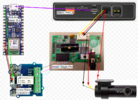kesawi
New Member
- Joined
- Jan 4, 2023
- Messages
- 7
- Reaction score
- 3
- Location
- Brisbane
- Country
- Australia
- Dash Cam
- Blackvue 900x-2CH Plus
I think that I've found a simpler solution to my problem in this thread using a single pole dual throw switch:
 dashcamtalk.com
dashcamtalk.com
I've sketched up the schematic below.

Avoids the need for relays and issues with coil surge.
Using the switch while the camera is on will cause a momentary loss of power to the Batt terminal of the camera and cause it to restart (can a capacitor be used?)
Adding ON/OFF switch to battery cable
I want to install a switch to my HK3 for the Viofo 129 Plus camera so I can turn off the camera parking mode in my garage instead of removing the power cable, I was wondering if I cut the red wire (battery) and connect the 2 wires to a 2-prong switch like shown in the picture, would that work...
I've sketched up the schematic below.

Avoids the need for relays and issues with coil surge.
Using the switch while the camera is on will cause a momentary loss of power to the Batt terminal of the camera and cause it to restart (can a capacitor be used?)


